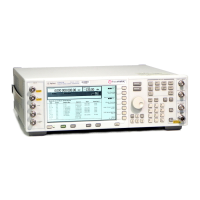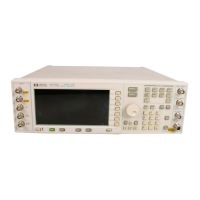Chapter 17 607
W-CDMA Downlink Digital Modulation for Receiver Test
Compressed Mode Overview
Compressed Mode Overview
Compressed mode is used when you need to create a discontinuous transmission period (DTX), also called a
transmission gap, so the user equipment (UE) can sample other frequencies. During the DTX period, the UE
can receive control information from either another W-CDMA base station or a GSM base station for a
handoff.
The UE must be able to receive the compressed frames and properly demodulate and decode the data along
with the normal frames. BER and BLER measurements are made on the data to ensure proper UE operation.
The ESG facilitates this type of testing by transmitting fully coded transport channels (DCH) for
compressed, normal, or a combination of compressed and normal frames. These fully coded channels can
automatically be configured using the provided reference measurement channels (RMC) or you can set your
own custom configurations. The ESG supports the following 3GPP defined DPCH channel configurations
for compressed mode:
• 12.2 kbps
• 64 kbps
• 144 kbps
• 384 kbps
• AMR 12.2 kbps
• UDI IDSN 64 kbps
With both the fully coded transport channels and the wide choice of RMCs, you are able to fully test the UE
for proper demodulation and decoding using BER testing. For more information on the supported RMCs,
see “Reference Measurement Channels” on page 632.
The compressed mode in the ESG complies with the 3GPP specifications and is very flexible with many
adjustable parameters. You can have one or two transmission gaps. When two gaps are used, each gap can
have a different length and operate using the single or double frame method. The double frame method uses
slots from two compressed frames to create one transmission gap. Table 17-1 describes some of the
parameters that are available for the compressed mode.

